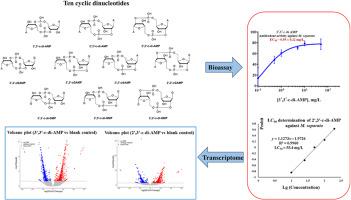Design, synthesis and bioactivity of cyclic dinucleotides against Lepidoptera insects
引用次数: 0
Abstract
Cyclic dinucleotides (CDNs) play important physiological roles in bacteria, mammals and insects as a novel class of signaling molecules. However, the application of CDNs in agricultural pest control has not been reported yet. To explore the potential bioactivity of CDNs on agricultural pests, we synthesized ten kinds of CDNs containing adenine and guanine bases with different internucleotide linkages (3′,3′; 2′,3′; 2′,2′). The target CDNs were used to determine the antifeedant and insecticidal activity against common Lepidoptera pests including S. frugiperda, M. separata, and H. armigera. The bioassay tests indicated that 3′,3′-c-di-AMP showed the highest antifeedant activity (EC50 = 0.59 mg/L) against M. separata larvae among all the tested CDNs. Regarding insecticidal activity, 2′,3′-c-di-AMP showed higher insecticidal activity against M. separata larvae with LC50 of 55.4 mg/L. RNA-seq further revealed that 3′,3′-c-di-AMP and 2′,3′-c-di-AMP exhibited a significant effect on the growth and development process of insects. More importantly, the bioactivity of 3′,3′-c-di-AMP was also closely correlated with the stimulation of insect immune inflammation. These results indicated that cyclic dinucleotides can affect the normal physiological process of insects, providing a new direction for managing pests.

针对鳞翅目昆虫的环状二核苷酸的设计、合成和生物活性
环状二核苷酸(CDNs)作为一类新型信号分子,在细菌、哺乳动物和昆虫体内发挥着重要的生理作用。然而,CDNs 在农业害虫防治中的应用尚未见报道。为了探索 CDNs 对农业害虫的潜在生物活性,我们合成了 10 种含有腺嘌呤和鸟嘌呤碱基的 CDNs,它们具有不同的核苷酸间连接(3′,3′;2′,3′;2′,2′)。目标 CDNs 被用于测定对常见鳞翅目害虫(包括鞘翅目蚜虫、鳞翅目蚜虫和鞘翅目蚜虫)的抗飞虱和杀虫活性。生物测定结果表明,在所有测试的 CDNs 中,3′,3′-c-di-AMP 对 M. separata 幼虫的抗食性活性最高(EC50 = 0.59 mg/L)。在杀虫活性方面,2′,3′-c-二-AMP 对裂头蝇幼虫的杀虫活性较高,半数致死浓度为 55.4 毫克/升。RNA-seq进一步发现,3′,3′-c-di-AMP和2′,3′-c-di-AMP对昆虫的生长发育过程有显著影响。更重要的是,3′,3′-c-二-AMP 的生物活性还与刺激昆虫免疫炎症密切相关。这些结果表明,环状二核苷酸能影响昆虫的正常生理过程,为治理害虫提供了新的方向。
本文章由计算机程序翻译,如有差异,请以英文原文为准。
求助全文
约1分钟内获得全文
求助全文

 求助内容:
求助内容: 应助结果提醒方式:
应助结果提醒方式:


